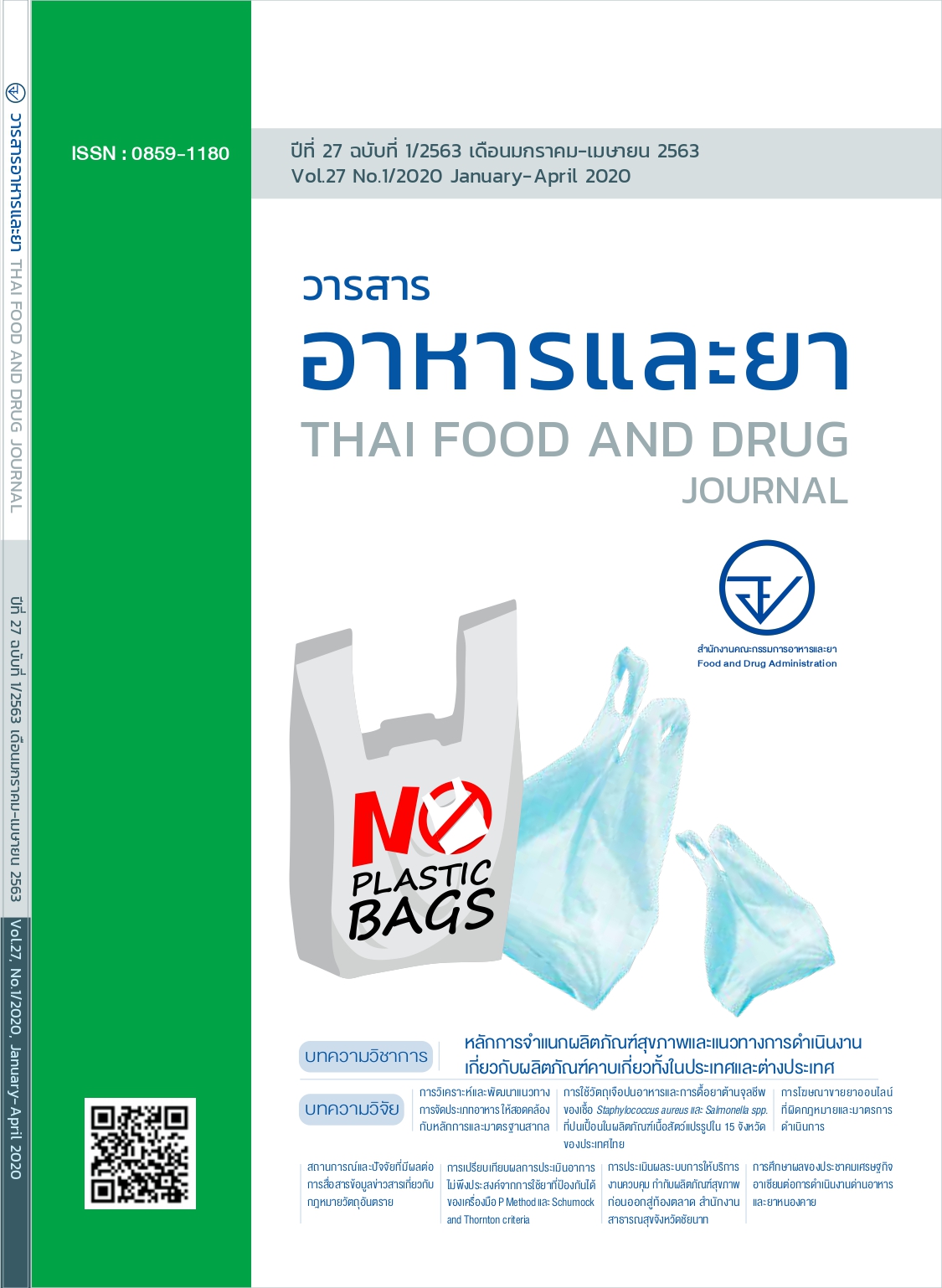การเปรียบเทียบผลการประเมินอาการไม่พึงประสงค์จากการใช้ยา ที่ป้องกันได้ของเครื่องมือ P Method และ Schumock and Thornton Criteria
Main Article Content
บทคัดย่อ
งานวิจัยนี้มีวัตถุประสงค์เพื่อเปรียบเทียบผลการประเมินอาการไม่พึงประสงค์จากการใช้ยาที่ป้องกันได้
(preventable adverse drug reactions; pADRs) ของเครื่องมือ P Method และ Schumock and Thornton
criteria รวมถึงคน้ หาสาเหตุและลักษณะของรายงานดังกลา่ ว โดยผู้ประเมิน 3 คน ประเมินรายงาน ADRs ยากลุ่ม
ระบบกล้ามเนื้อและโครงกระดูก จากโรงพยาบาลสังกัดสำนักงานปลัดกระทรวงสาธารณสุข ตั้งแต่ 1 ตุลาคม 2557 -
30 กันยายน 2560 ที่มีระดับความสัมพันธ์ใช่แน่นอน และเป็นรายงานที่ข้อมูลครบถ้วนตามเกณฑ์การประเมิน
คุณภาพรายงาน ในระดับ 3 ฐานข้อมูลศูนย์เฝ้าระวังความปลอดภัยด้านผลิตภัณฑ์สุขภาพ (Thai Vigibase)
วิเคราะห์ข้อมูลโดยใช้สถิติเชิงพรรณนา ได้แก่ ร้อยละ ทดสอบความแตกต่างของสัดส่วนรายงาน ด้วยสถิติ Fisher’s
exact test และหาความเชื่อมั่นระหว่างผู้ประเมิน ด้วยสถิติ Fleiss’s Kappa ผลการวิจัยพบว่ารายงาน ADRs
จำนวน 273 ฉบับ สว่ นใหญเ่ ปน็ เพศหญิง (รอ้ ยละ 65.93) มีอายุระหวา่ ง 15 - 59 ป (รอ้ ยละ 56.04) และเปน็ ผู้ปว่ ยนอก
รอ้ ยละ 72.16 รายงาน pADRs ที่ผู้ประเมินมีความเห็นตรงกันของแตล่ ะเครื่องมือ พบวา่ เปน็ รายงานที่ผู้ปว่ ยไดรั้บยา
กลุ่ม NSAIDs มากกวา่ 1 รายการ 2 ฉบับ และเปน็ รายงานที่ผู้ปว่ ยไดรั้บยาที่เคยมีประวัติการแพ 1 ฉบับ โดยสว่ นใหญเ่ ปน็
อาการทางระบบผิวหนัง สัดสว่ นของจำนวนรายงานเมื่อประเมินดว้ ยเครื่องมือที่แตกตา่ งกัน พบวา่ มีผู้ประเมิน 1 คน
ที่ผลการประเมินมีความแตกต่างกันอย่างมีนัยสำคัญทางสถิติ (P = 0.00) และเมื่อวิเคราะห์ค่าความสอดคล้องของ
เครื่องมือ พบว่าเครื่องมือ Schumock and Thontron criteria มีค่าความสอดคล้องมากกว่าเครื่องมือ P Method
โดยมีค่าความสอดคล้องในระดับปานกลาง (Fleiss’s Kappa = 0.44) ในขณะที่ P Method มีค่าความสอดคล้อง
วารสารอาหารและยา ฉบับเดือนมกราคม-เมษายน 2563 71
อยู่ในระดับเล็กน้อย (Fleiss’s Kappa = 0.15) และพบว่าสัดส่วนรายงานที่ผู้ประเมินเห็นตรงกันเมื่อประเมินด้วย
Schumock and Thontron criteria มีจำนวนมากกว่า P Method อย่างไรก็ตามรายงานส่วนใหญ่เป็นรายงาน
ที่ไม่สามารถประเมินได้ อาจเนื่องมาจากข้อมูลรายงาน ADRs จากฐานข้อมูล Thai Vigivase มีอย่างจำกัด จึงเสนอ
ใหมี้การพัฒนาแบบรายงาน ADRs ใหผู้้รายงานระบุขอ้ มูลที่จำเปน็ สำหรับการประเมิน pADRs เพื่อใหก้ ารประเมิน
ความเป็นไปได้ในการป้องกันอาการไม่พึงประสงค์ของรายงานแต่ละฉบับเป็นไปอย่างครอบคลุมและครบถ้วน
สามารถนำไปใช้เป็นข้อมูลสำหรับการกำหนดมาตรการการป้องกันและลดการเกิด pADRs ในระดับประเทศต่อไป
Article Details
เอกสารอ้างอิง
A practical guide to pharmacovigilance.กรุงเทพฯ: บริษัท ประชาชน จำกัด; 2547. หน้า 51-60.
2. Benkirane, R., et al. Assessment of a newinstrument for detecting preventable adversedrug reactions. Drug Saf 2015;38:383-93.
3. Aronson JK, Ferner RE. Preventability ofdrug-related harms - part II: proposed criteria,based on frameworks that classify adverse drug reactions. Drug Saf 2010;33:995-1002.
4. Ferner RE, Aronson JK. Preventability of drug-related harms - part I: a systematic review. Drug Saf 2010;33:985-94.
5. Schumock GT, Thornton JP. Focusing on the preventability of adverse drug reactions. Hosp Pharm 1992;27:538.
6. Olivier P, Boulbés O, Tubery M, Lauque D,Montastruc JL, Lapeyre-Mestre M. Assessing the feasibility of using an adverse drug reaction preventability scale in clinical
practice: a study in a French emergency department. Drug Saf 2002;25:1035-44.
7. Thomas R., et al. Putting the Kappa Statistic to Use. Qual Assur 2010;13:57-46.
8. ประสพชัย พสุนนท์. การประเมินความเชื่อมั่นระหวา่ งผู้ประเมินโดยใชส้ ถิติแคปปา. วารสารวิชาการศิลปศาสตร์ประยุกต์ 2558;8:2-20.


